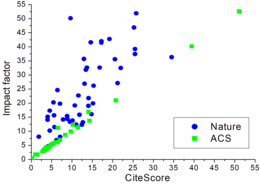CiteScore
CiteScore (CS) of an academic journal is a measure reflecting the yearly average number of citations to recent articles published in that journal. This journal evaluation metric was launched in December 2016 by Elsevier as an alternative to the generally used JCR impact factors (IFs). CiteScore is based on the citations recorded in the Scopus database rather than in JCR, and those citations are collected for articles published in the preceding four years instead of two or five.
Calculation
In any given year, the CiteScore of a journal is the number of citations, received in that year and previous 3 years, of documents published in the journal during that period (four years), divided by the total number of published documents (articles, reviews, conference papers, book chapters, and data papers) in the journal during the same four-year period:[1]
For example, Nature had a CiteScore of 50.96 in 2019:
Note that 2017 CiteScores are reported in 2018; they cannot be calculated until all of the 2017 publications have been processed by the indexing agency. CiteScores are typically released in late May,[2] approximately one month earlier than the JCR impact factors.[3] Scopus also provides the projected CiteScores for the next year, which are updated every month.[1]
CiteScore vs. Journal Impact Factor

CiteScore was designed to compete with the two-year JCR impact factor, which is currently the most widely used journal metric.[4][5] Their main differences are as follows:[6]
| Parameter | JCR IF | CiteScore |
|---|---|---|
| Evaluation period (years) | 2 | 4 |
| Database | JCR | Scopus |
| No. indexed journals (2016) | 11,000 | 22,000 |
| Access | Subscribers | Anyone |
| Evaluated items | Articles, reviews | All publications |
Another difference is the definition of the "number of publications" or "citable items".[6]
References
- Journal Metrics – FAQs. journalmetrics.scopus.com
- Elsevier releases 2017 CiteScore™ values. elsevier.com. 31 May 2018
- Journal Citation Reports 2018 Archived 2019-05-02 at the Wayback Machine. clarivate.com. 26 June 2018
- Gray, Edward (2008). "Comparison of Journal Citation Reports and Scopus Impact Factors for Ecology and Environmental Sciences Journals". doi:10.5062/F4FF3Q9G. Cite journal requires
|journal=(help) - Journal Citation Reports: JCR. The University of Notre Dame Australia
- Van Noorden, Richard (2016). "Controversial impact factor gets a heavyweight rival". Nature. 540 (7633): 325–326. Bibcode:2016Natur.540..325V. doi:10.1038/nature.2016.21131. PMID 27974784.